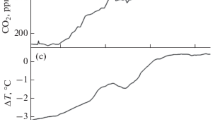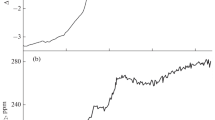Abstract
The paper reports the results of reconstruction of the heliospheric modulation potential from radiocarbon data for the time interval from the mid-second millennium B.C. to the end of the first millennium A.D. It is known that significant climatic changes took place on the Earth during that time; specifically, the thickness of glaciers in Iceland and Norway were changing. Coincident changes are also observed in the radiocarbon data. The results of calculations show that the heliospheric modulation potential reaches a maximum (~590 MV) on this interval approximately in 1705 B.C. This suggests that solar activity at that moment was highest for the considered interval. Conversely, around 750 and 350 B.C., the smallest values of the modulation potential were observed and, consequently, solar activity could be lowest from the mid-second millennium B.C. to the end of the first millennium A.D.


Similar content being viewed by others
REFERENCES
Borisenkov, E.P. and Pasetskii, V.M., Tysyacheletnyaya letopis’ neobychnykh yavlenii prirody (A Thousand-Year Chronicle of Unusual Natural Phenomena), Moscow, Mysl’, 1988.
Knudsen, M.F., Riisager, P., Donadini, F., et al., Variations in the geomagnetic dipole moment during the Holocene and the past 50 ky, Earth Planet. Sci. Lett., 2008, vol. 272, pp. 319–329.
Koudriavtsev, I.V., Dergachev, V.A., Nagovitsyn, Yu.A., Ogurtsov, M.G., and Junger, H., On the influence of climatic factors on the ratio between the cosmogenic isotope 14C and total carbon in the atmosphere in the past, Geochronometria, 2014, vol. 41, no. 3, pp. 216–222.
Kovaltsov, G.A., Mishev, A., and Usoskin, I.G., A new model of cosmogenic production of radiocarbon 14C in the atmosphere, Earth Planet. Sci. Lett., 2012, vols. 337–338, pp. 114–120.
Kudryavtsev, I.V., Volobuev, D.M., Dergachev, V.A., Nagovitsyn, Yu.A., and Ogurtsov, M.G., Reconstructions of the 14C cosmogenic isotope content of natural archives after the last glacial period, Geomagn. Aeron. (Engl. Transl.), 2016, vol. 56, no. 7, pp. 858–862.
Kudryavtsev, I.V., Volobuev, D.M., Dergachev, V.A., Nagovitsyn, Yu.A., and Ogurtsov, M.G., Reconstruction of the production rate of cosmogenic 14C in the Earth’s atmosphere for 17000–5000 BC, Geomagn. Aeron. (Engl. Transl.), 2018, vol. 58, no. 7, pp. 925–929.
Kuleshova, A.I., Dergachev, V.A., Kudryavtsev, I.V., Nagovitsyn, Yu.A., and Ogurtsov, M.G., Possible influence of climate factors on the reconstruction of the cosmogenic isotope 14C production rate in the Earth’s atmosphere and solar activity in past epochs, Geomagn. Aeron. (Engl. Transl.), 2015, vol. 55, no. 8, pp. 1071–1075.
Kuleshova, A.I., Dergachev, V.A., Kudryavtsev, I.V., Nagovitsyn, Yu.A., and Ogurtsov, M.G., Reconstruction of the wolf numbers based on radiocarbon data from the early 11th century until the middle of the 19th century with respect to climate changes, Geomagn. Aeron. (Engl. Transl.), 2018, vol. 58, no. 8, pp. 1097–1102.
Marcott, S.A. and Shakun, J.D., Holocene climate change and its context for the future, Pages Mag., 2015, vol. 23, no. 1, p. 28.
Marcott, S.A., Shakun, J.D., Clark, P.U., and Mix, A.C., A reconstruction of regional and global temperature for the past 11,300 years, Science, 2013, vol. 339, pp. 1198–1201.
Monnin, E., Indermuhle, A., Dallenbach, A., Fluckiger, J., Stauffer, B., Stocker, T.F., Raynaud, D., and Barnola, J.-M., Atmospheric CO2 concentrations over the last glacial termination, Science, 2001, vol. 291, pp. 112–114.
Poluianov, S.V., Kovaltsov, G.A., Mishev, A.L., and Usoskin, I.G., Production of cosmogenic isotopes 7Be, 10Be, 14C, 22Na, and 36Cl in the atmosphere: Altitudinal profiles of yield functions, J. Geophys. Res.: Atmos., 2016, vol. 121, pp. 8125–8136.
Reimer, P.J., Bard, E., Bayliss, A., et al., IntCal13 and MARINE13 radiocarbon age calibration curves 0–50000 years calBP, Radiocarbon, 2013, vol. 55, no. 4, pp. 1869–1887.
Roth, R. and Joos, F., A reconstruction of radiocarbon production and total solar irradiance from the Holocene 14C and CO2 records: Implications of data and model uncertainties, Clim. Past, 2013, vol. 9, pp. 1879–1909.
Usoskin, I.G., Hulot, G., Gallet, Y., Roth, R., Licht, A., Joos, F., Kovaltsov, G.A., Thébault, E., and Khokhlov, A., Evidence for distinct modes of solar activity, Astron. Astrophys., 2014, vol. 562, L10562.
Funding
The work was supported in part by the Russian Foundation for Basic Research, project nos. 18-02-0000583 and 19-02-00088.
Author information
Authors and Affiliations
Corresponding author
Ethics declarations
The authors declare that they have no conflict of interest.
Additional information
Translated by E. Petrova
Rights and permissions
About this article
Cite this article
Dergachev, V.A., Kudryavtsev, I.V. & Nagovitsyn, Y.A. Solar Activity from the Mid-Second Millennium B.C. to the First Millennium A.D. Based on Radiocarbon Data. Geomagn. Aeron. 59, 846–849 (2019). https://doi.org/10.1134/S0016793219070119
Received:
Revised:
Accepted:
Published:
Issue Date:
DOI: https://doi.org/10.1134/S0016793219070119




